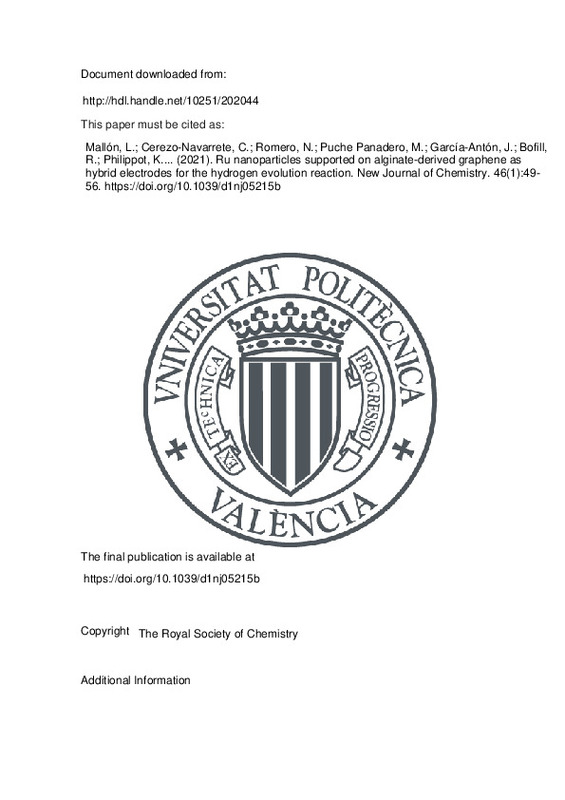JavaScript is disabled for your browser. Some features of this site may not work without it.
Buscar en RiuNet
Listar
Mi cuenta
Estadísticas
Ayuda RiuNet
Admin. UPV
Ru nanoparticles supported on alginate-derived graphene as hybrid electrodes for the hydrogen evolution reaction
Mostrar el registro sencillo del ítem
Ficheros en el ítem
| dc.contributor.author | Mallón, Laura
|
es_ES |
| dc.contributor.author | Cerezo-Navarrete, Christian
|
es_ES |
| dc.contributor.author | Romero, Nuria
|
es_ES |
| dc.contributor.author | Puche Panadero, Marta
|
es_ES |
| dc.contributor.author | García-Antón, Jordi
|
es_ES |
| dc.contributor.author | Bofill, Roger
|
es_ES |
| dc.contributor.author | Philippot, Karine
|
es_ES |
| dc.contributor.author | Martínez-Prieto, Luis M.
|
es_ES |
| dc.contributor.author | Sala, Xavier
|
es_ES |
| dc.date.accessioned | 2024-01-19T19:02:56Z | |
| dc.date.available | 2024-01-19T19:02:56Z | |
| dc.date.issued | 2021-12-20 | es_ES |
| dc.identifier.issn | 1144-0546 | es_ES |
| dc.identifier.uri | http://hdl.handle.net/10251/202044 | |
| dc.description.abstract | [EN] The development of organic-inorganic hybrid materials for redox catalysis is key to access new energy conversion schemes and the sustainable production of dihydrogen. Here, bare and P-doped graphene arising from the pyrolysis of biomass (alginate from marine algae) has been used as a support for the growth and stabilization of ultra-small Ru/RuO2 NPs through organometallic synthesis. P-doped graphene allows obtaining smaller and better dispersed NPs in hybrid electrodes of lower roughness and electroactive surface area. Electrochemical activation of the as-synthesised supported nanoparticles by reduction of the passivating RuO2 layer generates excellent HER electrocatalysts under acidic conditions (eta(10) of 29 mV and 15 mV for the bare and P-doped electrodes, respectively). P doping, identified as surface phosphates by P-31 solid state NMR, induces improvement of all HER benchmarking parameters studied, including overpotential and exchange and specific current densities. All studied materials show excellent long-term stability and selectivity for hydrogen generation with no sign of deactivation after 12 h under turnover conditions and almost quantitative faradaic efficiencies. | es_ES |
| dc.description.sponsorship | The authors thank Instituto de Tecnologia Quimica (ITQ), Consejo Superior de Investigaciones Cientificas (CSIC), Universitat Politecnica de Valencia (UPV), and Universitat Autonoma de Barcelona for the facilities. Electron Microscopy Service of the UPV for TEM facilities and J. A. Vidal-Moya (ITQ, CSIC-UPV) for NMR measurements are also thanked. We also gratefully acknowledge Prof. A. Corma for his contribution to this research. C. C.-N. acknowledges Generalitat Valenciana predoctoral fellowship (GVA: ACIF/2019/076) and L. M. the UAB for a PhD grant. This work was financially supported by the MINECO/FEDER project PID2019-104171RB-I00. J. G.-A. acknowledges the Serra Hunter Program. CNRS and Universite de Toulouse-Paul Sabatier are also acknowledged. | es_ES |
| dc.language | Inglés | es_ES |
| dc.publisher | The Royal Society of Chemistry | es_ES |
| dc.relation.ispartof | New Journal of Chemistry | es_ES |
| dc.rights | Reserva de todos los derechos | es_ES |
| dc.subject | N-Doped Graphene | es_ES |
| dc.subject | Ruthenium | es_ES |
| dc.subject | Catalyst | es_ES |
| dc.subject | Energy | es_ES |
| dc.title | Ru nanoparticles supported on alginate-derived graphene as hybrid electrodes for the hydrogen evolution reaction | es_ES |
| dc.type | Artículo | es_ES |
| dc.identifier.doi | 10.1039/d1nj05215b | es_ES |
| dc.relation.projectID | info:eu-repo/grantAgreement/AEI/Plan Estatal de Investigación Científica y Técnica y de Innovación 2017-2020/PID2019-104171RB-I00/ES/NANOMATERIALES CATALITICOS CONFECCIONADOS A MEDIDA PARA LA PRODUCCION DE COMBUSTIBLES SOLARES Y PRODUCTOS QUIMICOS DE VALOR AÑADIDO/ | es_ES |
| dc.relation.projectID | info:eu-repo/grantAgreement/GVA//ACIF%2F2019%2F076/ | es_ES |
| dc.rights.accessRights | Abierto | es_ES |
| dc.contributor.affiliation | Universitat Politècnica de València. Instituto Universitario Mixto de Tecnología Química - Institut Universitari Mixt de Tecnologia Química | es_ES |
| dc.description.bibliographicCitation | Mallón, L.; Cerezo-Navarrete, C.; Romero, N.; Puche Panadero, M.; García-Antón, J.; Bofill, R.; Philippot, K.... (2021). Ru nanoparticles supported on alginate-derived graphene as hybrid electrodes for the hydrogen evolution reaction. New Journal of Chemistry. 46(1):49-56. https://doi.org/10.1039/d1nj05215b | es_ES |
| dc.description.accrualMethod | S | es_ES |
| dc.relation.publisherversion | https://doi.org/10.1039/d1nj05215b | es_ES |
| dc.description.upvformatpinicio | 49 | es_ES |
| dc.description.upvformatpfin | 56 | es_ES |
| dc.type.version | info:eu-repo/semantics/publishedVersion | es_ES |
| dc.description.volume | 46 | es_ES |
| dc.description.issue | 1 | es_ES |
| dc.relation.pasarela | S\452368 | es_ES |
| dc.contributor.funder | Generalitat Valenciana | es_ES |
| dc.contributor.funder | Agencia Estatal de Investigación | es_ES |
| dc.contributor.funder | European Regional Development Fund | es_ES |
| dc.contributor.funder | Universitat Autònoma de Barcelona | es_ES |
| dc.contributor.funder | Universitat Politècnica de València | es_ES |
| dc.contributor.funder | Université Toulouse III Paul Sabatier | es_ES |
| dc.contributor.funder | Instituto de Tecnología Química UPV-CSIC | es_ES |
| dc.contributor.funder | Consejo Superior de Investigaciones Científicas | es_ES |







![[Cerrado]](/themes/UPV/images/candado.png)

